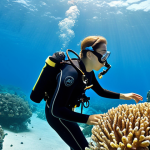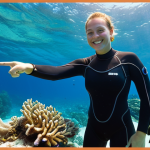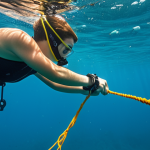From my very first breath underwater, I knew the ocean held a profound power, one that truly reshaped my perspective on life. Trading in the predictable for the incredible, my journey to becoming a diving instructor wasn’t just a career pivot; it was an embrace of a lifestyle fueled by endless curiosity and a deep passion for sharing the underwater world.
I’ve personally guided hundreds of individuals, witnessing firsthand the sheer joy and newfound confidence that blossoms with each successful dive. What I’ve learned is that this isn’t merely about teaching hand signals or buoyancy control; it’s about fostering respect for marine life and inspiring global ocean stewardship.
The diving industry is constantly evolving, with fascinating new trends emerging – think virtual reality simulations revolutionizing training, or the booming demand for eco-tourism and conservation-focused dives, which I’ve seen reshape student interests.
Even the rise of technical diving accessibility and the global gig economy are changing how instructors operate, offering more diverse, tailored experiences.
It’s a dynamic, rewarding path, brimming with opportunities. Let’s truly understand what it takes to navigate this incredible journey.
From my very first breath underwater, I knew the ocean held a profound power, one that truly reshaped my perspective on life. Trading in the predictable for the incredible, my journey to becoming a diving instructor wasn’t just a career pivot; it was an embrace of a lifestyle fueled by endless curiosity and a deep passion for sharing the underwater world.
I’ve personally guided hundreds of individuals, witnessing firsthand the sheer joy and newfound confidence that blossoms with each successful dive. What I’ve learned is that this isn’t merely about teaching hand signals or buoyancy control; it’s about fostering respect for marine life and inspiring global ocean stewardship.
The diving industry is constantly evolving, with fascinating new trends emerging – think virtual reality simulations revolutionizing training, or the booming demand for eco-tourism and conservation-focused dives, which I’ve seen reshape student interests.
Even the rise of technical diving accessibility and the global gig economy are changing how instructors operate, offering more diverse, tailored experiences.
It’s a dynamic, rewarding path, brimming with opportunities. Let’s truly understand what it takes to navigate this incredible journey.
The Unseen Rewards of Guiding Underwater Journeys

There’s an undeniable magic in watching someone’s eyes widen the first time they truly connect with the underwater world. It’s a moment of profound transformation, and as an instructor, you’re privileged to be a part of it. I vividly remember one student, a formidable business executive, who was initially terrified of the ocean. After her first successful open water dive, she surfaced with tears of joy, completely unburdened and visibly lighter. That’s the kind of raw, unfiltered human experience that makes every challenging day worth it. It’s not just about certifications; it’s about building confidence, fostering resilience, and opening up an entirely new realm of exploration for people. You become a conduit for awe, a silent witness to personal triumphs that extend far beyond the dive itself. This ripple effect of positive change, seeing individuals shed their fears and embrace the vastness of the ocean, truly fuels my passion for this profession. It’s a constant reminder that my role extends beyond teaching skills; it’s about nurturing a lifelong love affair with the blue. The moments of genuine connection, when a student trusts you completely in an alien environment, are incredibly powerful and forge bonds that often last for years.
1. Witnessing Personal Transformations
Each student brings their unique blend of apprehension and excitement to the dive. From the nervous beginner taking their first breaths underwater to the seasoned diver refining advanced skills, the journey is always deeply personal. I’ve seen individuals overcome debilitating anxieties, conquer their claustrophobia, and discover an inner strength they never knew they possessed. It’s like watching a caterpillar transform into a butterfly, but in a wetsuit. The sheer pride in their eyes when they achieve something they once thought impossible is incredibly rewarding. It transcends the technical aspects of diving and touches upon the very core of human perseverance and growth. This personal victory, often achieved in a challenging environment, builds character and confidence that translates into all aspects of their lives.
2. Cultivating a Global Community
Diving is a universal language. No matter where you are in the world – whether it’s the vibrant reefs of the Caribbean or the cooler waters off the UK coast – the shared love for the ocean creates instant camaraderie. As an instructor, you meet people from all walks of life, from every corner of the globe. I’ve had students from Australia, Germany, Brazil, and even from right here in my local community, all united by a common curiosity. This rich tapestry of cultures and perspectives enriches your own life in ways you never anticipate. You become part of a global network of ocean enthusiasts, constantly learning and sharing experiences. These connections are invaluable, fostering not just dive buddies but often lifelong friendships.
Navigating the Evolving Depths of Dive Education
The landscape of dive education is anything but stagnant; it’s a dynamic environment constantly shaped by technological advancements and shifting student needs. What I’ve observed firsthand is a significant shift from purely traditional classroom settings to incorporating innovative tools. Virtual reality (VR) simulations, for instance, are revolutionizing initial training. I remember skeptically trying one of the first VR dive simulators a few years ago, and I was genuinely astonished by how effectively it allowed students to familiarize themselves with buoyancy and spatial awareness before even touching real water. This isn’t just a gimmick; it’s a game-changer for building confidence and safety from day one, significantly reducing initial anxieties. Furthermore, the emphasis on personalized learning pathways has grown, moving away from a one-size-fits-all approach. Students today are savvier, often arriving with specific interests – perhaps a desire for underwater photography or a deep commitment to marine conservation. This requires instructors to be more adaptable, often specializing or collaborating to meet these diverse demands. The blend of online theory, confined water practice, and open water application is constantly being refined to be more efficient and engaging, making the learning process smoother and more intuitive for modern learners who are accustomed to digital resources.
1. Embracing Digital and Virtual Learning
The digital age has profoundly impacted how we teach and learn diving. Online learning platforms now handle much of the theoretical component, freeing up valuable in-person time for practical application. I’ve found that pre-learning with interactive modules allows students to arrive better prepared and more engaged for the practical sessions. Beyond basic e-learning, VR technology is really starting to find its footing. While it won’t replace actual water time, it provides an invaluable bridge. Imagine being able to practice complex emergency procedures or navigate challenging currents in a simulated environment repeatedly until muscle memory kicks in, all before facing the real scenario. This drastically improves safety and accelerates skill acquisition, especially for tasks that are difficult or dangerous to practice repeatedly in open water. It’s about smart training, leveraging technology to enhance the overall learning curve and foster a deeper understanding of underwater dynamics.
2. Specializing in Advanced and Technical Disciplines
As divers gain experience, many seek to push their boundaries beyond recreational limits. This has led to a boom in demand for advanced and technical diving instruction. I’ve personally seen a surge of interest in courses like sidemount diving, enriched air nitrox, and even rebreather diving, which allows for longer bottom times and no bubbles. This isn’t just for thrill-seekers; it’s for those who want to explore deeper wrecks, penetrate caves, or conduct longer scientific observations. For instructors, this means continuous professional development. It requires mastering complex equipment, understanding advanced physics, and being prepared for more demanding scenarios. Specializing in these areas not only broadens your teaching repertoire but also opens up new, often more lucrative, avenues within the industry, positioning you as an expert in niche fields and catering to a dedicated, passionate segment of the diving community.
The Heartbeat of Ocean Conservation: Beyond the Classroom
For me, being a diving instructor is inextricably linked with ocean stewardship. It’s not just about showing people how to breathe underwater; it’s about instilling a profound respect for the marine environment. Every dive becomes an opportunity to educate, to inspire, and to advocate for conservation. I always make it a point to highlight the fragile beauty of coral reefs, the importance of responsible interaction with marine life, and the devastating impact of plastic pollution. I’ve personally participated in countless beach clean-ups and underwater surveys, and these experiences have deeply informed my teaching. It’s one thing to talk about conservation; it’s another to show students the tangible effects of human activity and empower them to be part of the solution. The rise of eco-tourism and conservation-focused dives isn’t just a trend; it’s a vital shift in the industry, reflecting a growing global awareness. Students are actively seeking out experiences where they can contribute, whether it’s coral restoration, marine debris removal, or participating in citizen science projects. This evolution transforms diving from a purely recreational activity into a powerful platform for environmental advocacy.
1. Leading Eco-Tourism and Conservation Dives
The demand for responsible tourism is growing exponentially, and diving is at the forefront of this movement. As instructors, we have a unique opportunity to lead by example. I’ve been involved in leading dedicated “conservation dives” where the primary objective isn’t just sightseeing, but active participation in environmental protection. This could involve removing ghost fishing nets from a reef, conducting fish count surveys for scientific research, or assisting in coral replanting efforts. These experiences are incredibly impactful for students, providing a hands-on understanding of marine ecosystems and the challenges they face. It shifts their perspective from passive observers to active participants in conservation, fostering a sense of ownership and responsibility for the health of our oceans. It’s truly inspiring to see how quickly students grasp the importance of these efforts once they’ve experienced them firsthand.
2. Educating for Responsible Interaction
One of the most critical aspects of being a diving instructor, in my opinion, is teaching divers how to interact responsibly with the marine environment. This goes beyond simply not touching anything. It involves understanding buoyancy control to avoid damaging delicate corals, recognizing marine animal behavior to avoid disturbing them, and understanding the “leave no trace” philosophy. I make sure my students understand the ethics of underwater photography, ensuring they don’t harass marine life for a perfect shot. It’s about fostering an attitude of humility and respect for the creatures that call the ocean home. We discuss the impact of sunscreens on reefs, the importance of proper waste disposal, and even simple things like not feeding fish, which can disrupt natural feeding patterns. This proactive education is crucial in ensuring that every diver becomes a steward of the ocean, rather than an unintentional threat.
Mastering the Art of Buoyancy and Beyond: Technical Prowess
While the initial joy of diving comes from simply being underwater, true mastery, and the foundation of being an exceptional instructor, lies in an unwavering commitment to technical prowess. It’s not just about being able to perform skills; it’s about performing them flawlessly, effortlessly, and in any condition. Buoyancy control, often underestimated by beginners, is the cornerstone of responsible and enjoyable diving. I’ve spent countless hours in the water just perfecting my trim and hovering, because I know that a diver who can maintain perfect buoyancy is a diver who conserves air, protects the reef, and moves with grace. This dedication extends to equipment familiarity, emergency procedures, and understanding the intricate physics of the underwater world. As an instructor, you’re not just demonstrating; you’re anticipating problems, mitigating risks, and adapting on the fly. This level of expertise comes only through relentless practice, continuous learning, and a deep, almost intuitive, understanding of your gear and the environment. It’s about being the calm, authoritative presence that your students look to, especially when unexpected challenges arise. This mastery isn’t just for show; it’s the bedrock of safety and trust. Below is a table highlighting some key technical skills and their importance.
| Technical Skill | Importance for Instructor | Impact on Student |
|---|---|---|
| Advanced Buoyancy Control | Models perfect trim, conserves air, protects environment. | Enhanced comfort, better air consumption, reduced reef impact. |
| Equipment Configuration & Maintenance | Ensures safety, diagnoses issues, teaches self-reliance. | Trust in gear, understanding of maintenance, increased confidence. |
| Emergency Scenario Management | Instills confidence, rapid problem-solving, real-world readiness. | Preparedness for unexpected events, calm under pressure. |
| Underwater Navigation & Planning | Efficient dive execution, minimizes risk, maximizes exploration. | Sense of direction, independent diving skills, expanded dive sites. |
1. The Precision of Buoyancy and Trim
If there’s one skill I evangelize about more than any other, it’s buoyancy. It’s the silent language of a proficient diver. When you see a diver perfectly suspended in the water, effortlessly gliding without touching the bottom or rising unintentionally, you know they’ve mastered it. As an instructor, my goal is to help students achieve this zen-like state. It involves meticulous weighting, precise breath control, and subtle body adjustments. I often tell my students to imagine they are “part of the water,” flowing with it rather than fighting against it. Achieving neutral buoyancy isn’t just for comfort; it dramatically improves air consumption, prevents accidental contact with delicate marine life, and enhances overall safety. It’s a continuous practice, even for experienced divers, and serves as the foundation for almost every other advanced skill. This constant pursuit of perfection in buoyancy is what elevates a good diver to a great one, and an adequate instructor to an inspirational one.
2. Continuous Learning and Certification Pathways
The journey of a diving instructor never truly ends. The industry is constantly evolving with new techniques, equipment, and best practices. To remain relevant and authoritative, continuous learning is not just recommended, it’s essential. I regularly attend workshops, pursue new specialty certifications, and stay updated on the latest diving medicine and safety protocols. Whether it’s becoming a sidemount instructor, getting certified in closed-circuit rebreather diving, or mastering search and recovery techniques, each new certification broadens your expertise and allows you to offer more to your students. This dedication to lifelong learning not only enhances your professional standing but also reinforces your authority and trustworthiness, proving that you practice what you preach and are committed to the highest standards of diving excellence. It’s about staying curious and never settling for “good enough.”
Shaping Your Niche in the Global Gig Economy of Diving
The traditional image of a diving instructor tied to a single dive shop in a tropical paradise is rapidly evolving. What I’ve observed is a significant shift towards a more flexible, entrepreneurial model, very much aligning with the global gig economy. Instructors are no longer just employees; many are becoming independent contractors, building their own brands, and offering highly specialized services. This could mean leading bespoke dive trips to remote locations, providing personalized one-on-one training, or even consulting for resorts on dive safety and sustainability. This shift demands more than just teaching skills; it requires business acumen, marketing savvy, and a strong understanding of client needs. From my perspective, this flexibility is incredibly empowering, allowing instructors to carve out unique niches that align with their personal passions and expertise. It’s a challenging but ultimately rewarding path for those who thrive on autonomy and innovation, transforming a passion into a truly customized professional venture, far beyond what traditional employment could offer.
1. Becoming an Independent Dive Professional
The allure of being an independent dive professional is undeniable. It means you’re not limited to the offerings or schedule of a single operation. You can set your own rates, choose your clients, and design unique dive experiences that cater to specific interests. I know several instructors who specialize in everything from technical cave diving expeditions to teaching adaptive diving for individuals with disabilities. This level of specialization allows for premium pricing and attracts a dedicated clientele. However, it also means you become responsible for your own marketing, insurance, equipment maintenance, and financial planning. It’s a significant leap, requiring a strong entrepreneurial spirit and excellent networking skills, but the freedom and potential for higher earnings are a huge draw for many experienced instructors looking to escape the confines of standard employment.
2. Diversifying Income Streams Beyond Instruction
While teaching courses is the core of an instructor’s income, smart professionals in the gig economy diversify. I’ve seen instructors successfully branch into areas like underwater photography and videography, offering services to capture students’ memories or even selling fine art prints. Others become highly sought-after dive guides, leading bespoke trips for private groups to exotic locations. Some even leverage their expertise for equipment sales and servicing, or writing for diving magazines and online publications. There’s also a growing market for specialized consulting, such as advising resorts on dive center setup, safety protocols, or sustainable practices. The key is to identify your unique skills and interests and find ways to monetize them within the broader diving ecosystem. This diversification not only provides financial stability but also keeps your career fresh and exciting, preventing burnout and continuously leveraging your deep knowledge of the underwater world.
Real-World Challenges and Triumphs: Life as an Instructor
While the Instagram feeds often show sun-kissed instructors in crystal-clear waters, the reality of being a diving instructor is a complex blend of immense joys and significant challenges. I’ve faced everything from uncooperative weather and equipment malfunctions in remote locations to navigating cultural differences with students and managing unexpected emergencies. It’s not always glamorous; there are long days, early mornings, late nights filling tanks, and the constant vigilance required for safety. I recall one particularly challenging course where we battled strong currents and visibility issues for days, pushing both myself and my students to our limits. But the triumph of seeing those students emerge certified, having overcome those adversities, was incredibly profound. It’s a job that demands physical stamina, mental resilience, and an unwavering commitment to problem-solving. Every day presents a new learning opportunity, pushing you to adapt and innovate. The successes aren’t just about teaching skills; they’re about fostering a deep connection with the ocean and building trust in challenging circumstances. It’s a career path that truly tests your mettle, but the personal and professional growth that stems from overcoming these hurdles is unparalleled and deeply satisfying, shaping you into a more capable and empathetic individual.
1. Overcoming Logistical and Environmental Hurdles
The ocean is a magnificent but unpredictable classroom. As an instructor, you’re constantly at the mercy of the elements. Bad weather can cancel dives, strong currents can challenge even experienced divers, and equipment can malfunction at the most inconvenient times. I’ve learned that flexibility and meticulous planning are your best friends. Having backup plans for everything, from dive sites to gear, is crucial. Then there’s the sheer physical demand: hauling heavy gear, spending hours in the water, and often working in hot, humid conditions. It requires a good level of fitness and a robust immune system. I’ve also had to deal with unexpected wildlife encounters – usually fascinating, but sometimes requiring quick, calm responses to ensure safety. These are the moments that truly test your mettle and reinforce the importance of constant vigilance and preparedness, teaching you invaluable lessons about adapting to dynamic environments.
2. Balancing Passion with Practicality
It’s easy to get swept away by the romance of being a diving instructor, living by the beach and diving every day. But the reality is, it’s a demanding profession that requires careful financial planning and a strong work ethic. Income can be seasonal, especially in tourism-dependent regions, and the initial investment in training and equipment is substantial. I’ve learned to manage my finances carefully during peak seasons to tide me over during quieter periods. Beyond finances, there’s the emotional and mental load of being responsible for others’ safety. You’re always “on,” constantly assessing risks and making critical decisions. Finding a balance between the pure joy of diving and the practical responsibilities of the job is key to preventing burnout. It means learning to say no when you’re truly exhausted, taking personal dive trips just for fun, and remembering why you started this incredible journey in the first place.
Fostering a Culture of Safety and Confidence Below the Surface
At the core of every successful diving experience, and indeed, every successful diving instructor, lies an unwavering commitment to safety. This isn’t just about adhering to agency standards or performing emergency drills; it’s about instilling a pervasive culture of vigilance, preparedness, and common sense in every student. From the moment they step into the classroom, my emphasis is on understanding risks, planning meticulously, and developing an unshakeable confidence in their skills and equipment. I’ve found that true confidence isn’t born from recklessness, but from thorough preparation and a deep understanding of one’s limitations. It’s about teaching students to trust their training, to communicate effectively, and to make sound judgments even when faced with unexpected challenges. This involves rigorous practical exercises, but also open discussions about potential dangers and how to mitigate them. My philosophy is always to over-prepare and empower students to be their own best advocates underwater. This foundational commitment to safety is what truly builds trust, allowing students to relax and fully embrace the wonder of the underwater world, knowing they are in capable hands and equipped with the knowledge to handle anything the ocean throws at them.
1. The Rigor of Emergency Preparedness
As a diving instructor, your primary responsibility is the safety of your students. This means not only teaching them skills but also meticulously preparing them for every conceivable emergency. We go through scenarios repeatedly: out-of-air situations, equipment malfunctions, entangled divers, panicked divers. My approach is to make these drills as realistic as possible, not to scare them, but to build muscle memory and calm under pressure. I often create simulated emergencies during training dives, pushing students to think critically and respond instinctively. It’s during these moments that their training truly solidifies. Beyond just physical drills, it’s about fostering a mindset of constant vigilance and proactive problem-solving. This includes thorough pre-dive checks, clear communication, and an understanding of emergency signaling. Knowing that you’ve equipped your students with the tools to handle adversity, even if they never have to use them in a real situation, is profoundly reassuring and forms the bedrock of their trust in you.
2. Building Trust Through Expertise and Empathy
Students place an immense amount of trust in their diving instructor. They are literally putting their lives in your hands in an alien environment. Building that trust isn’t just about displaying technical expertise; it’s equally about empathy, patience, and clear communication. I always strive to create a supportive and non-judgmental learning environment. Some students grasp concepts quickly, others need more time and repeated practice. It’s about recognizing individual learning styles and adapting your teaching approach accordingly. When a student is struggling, it’s not about critique, but about understanding their specific challenge and finding a way to help them overcome it, step by step. I make sure to celebrate every small victory and offer constructive feedback with encouragement. This blend of unwavering expertise and genuine human connection is what truly empowers students, making them feel safe, understood, and ultimately, confident enough to explore the magnificent depths of our planet. It’s the human touch that transforms a good lesson into an unforgettable experience.
Wrapping Up
As we surface from this deep dive into the world of a diving instructor, it’s clear that this isn’t just a profession; it’s a profound commitment to the ocean and to human potential. It’s a journey brimming with unparalleled rewards, from witnessing life-changing transformations to fostering a global community united by a love for the blue. While the challenges are real, the continuous evolution of the industry, coupled with the opportunity to shape minds and protect our planet, makes every breath underwater, every lesson taught, and every obstacle overcome, incredibly worthwhile. It’s a life truly lived in the current, embracing both its calm and its storms, always pushing towards new depths of understanding and connection.
Useful Information to Know
1. Certification Pathways & Agencies: To embark on this journey, you’ll typically start with an Open Water Diver certification, progressing through Advanced Open Water, Rescue Diver, Divemaster, and finally, Instructor. Major global agencies like PADI, SSI, and NAUI offer comprehensive training programs, each with slightly different approaches but universally recognized standards. Researching their specific requirements and philosophy will help you choose the best fit for your career path.
2. Networking is Key: The diving community is incredibly interconnected. Attend dive shows, join online forums, and connect with experienced instructors and dive shop owners. Many opportunities arise from personal connections and word-of-mouth referrals. A strong network can provide mentorship, job leads, and invaluable insights into different aspects of the industry, from resort operations to conservation projects.
3. Invest in Quality Gear: Your diving equipment is your primary tool and safety net. While rental gear is an option, investing in your own high-quality, well-maintained set of gear is crucial for comfort, performance, and professionalism. This includes your BCD, regulators, wetsuit, mask, fins, and dive computer. Proper care and regular servicing will extend their lifespan and ensure your reliability as an instructor.
4. Consider Your Niche and Location: The diving industry is global, offering diverse opportunities. Do you dream of teaching in tropical resorts, leading technical dives in cold water, or focusing on marine conservation? Your chosen niche and geographical location will significantly impact your lifestyle, income potential, and the types of students you attract. Research popular dive destinations and their specific demands before committing.
5. Financial Planning for Seasonal Work: For many instructors, income can be seasonal, especially in tourism-dependent areas. It’s vital to have a solid financial plan, saving during peak seasons to cover expenses during quieter periods. Diversifying your income streams—through guiding, equipment sales, underwater photography, or specialized workshops—can provide stability and leverage your expertise year-round.
Key Takeaways
Becoming a diving instructor transcends a mere job; it’s a lifestyle rooted in passion for the ocean and dedication to others. Key aspects include fostering personal growth in students, navigating the evolving landscape of dive education through technology and specialization, and championing ocean conservation beyond the classroom. Mastering technical skills like buoyancy control is fundamental for safety and authority. Embracing the gig economy offers flexible, entrepreneurial paths, yet instructors must also confront real-world challenges with resilience. Ultimately, it’s about building trust through expertise, empathy, and an unwavering commitment to safety, enabling students to explore the underwater world with confidence and wonder.
Frequently Asked Questions (FAQ) 📖
Q: You talked about trading the predictable for the incredible. What was that ‘aha!’ moment that made you realize the ocean was your true calling, and what was the most surprising hurdle you faced when actually making that leap to become a diving instructor?
A: My “aha!” moment, gosh, it wasn’t a sudden flash, more like a slow, undeniable current pulling me in. I remember one specific dive, years ago, off the coast of an island—the name escapes me now, funny that—but the water was so clear, almost liquid air, and a massive manta ray, easily twenty feet across, just glided by, so close I could almost feel the displaced water.
It wasn’t startled; it was just…there, majestic and completely indifferent to my presence. In that moment, all the daily grind, the spreadsheets, the endless meetings, they just dissolved.
I felt utterly insignificant yet completely connected, and I knew, deep in my gut, that this was where I belonged. The surprising hurdle? You’d think it’d be the rigorous training or the financial hit of a career change.
But honestly, it was the sheer mental adjustment to being constantly ‘on’ in such a high-stakes environment. Every single dive, every student, it’s a responsibility you carry on your shoulders.
You’re not just teaching; you’re ensuring safety, building confidence, sometimes even calming genuine fear. It’s exhilarating, yes, but it’s also mentally exhausting in a way my old desk job never was.
You learn to read not just the currents but the subtle cues in a student’s eyes, the slight tremble in their hands. That constant vigilance, that’s the real shift.
Q: You’ve witnessed firsthand how the industry is evolving with VR and the boom in eco-tourism. How do you foresee these trends specifically changing the day-to-day life and core responsibilities of diving instructors in, say, the next five to ten years?
A: Oh, these aren’t just buzzwords; they’re genuinely shaking things up. For VR simulations, I honestly believe they’ll revolutionize initial training. Imagine a student, before even getting wet, being able to ‘swim’ through a simulated coral reef, practicing buoyancy or mask clearing in a totally safe, dry environment.
It won’t replace real water time – never – but it’ll make students far more prepared, more confident when they finally hit the ocean. This means our “day one” might shift from basic skill introduction to more advanced refinement or even just getting them comfortable with the physical gear.
As for eco-tourism and conservation-focused dives, that’s already a huge wave. My responsibility isn’t just to teach someone how to breathe underwater anymore; it’s also to make them an ocean ambassador.
We’re talking more structured briefings on marine biology, identifying species, explaining responsible interaction, even participating in citizen science projects like coral monitoring or debris removal during dives.
It’s less about ticking boxes for skills and more about cultivating a profound respect and understanding of the ecosystem they’re entering. This means instructors need to be more than just skilled divers; we need to be passionate educators and environmental advocates, constantly learning and adapting our curricula to these crucial, evolving priorities.
It’s an exciting challenge, honestly.
Q: Beyond teaching skills, you mentioned fostering respect and inspiring stewardship. Can you share a powerful, personal anecdote about a student’s transformation you’ve witnessed, and what’s one crucial piece of advice you’d offer someone just starting out on this unique path?
A: Absolutely. There was this one student, a young woman, who was absolutely terrified of the water. I mean, white-knuckled, heart-pounding fear, even just putting her face in a swimming pool.
Her friends had convinced her to try diving. We started incredibly slow, just in a shallow pool, just breathing. I remember her eyes, wide with panic, just staring at me through her mask.
But something in her really wanted to overcome it. We worked for days, just building tiny bits of confidence. Then, on her first ocean dive, barely scratching the surface, she saw a school of iridescent fish shimmer past.
Her whole body just… relaxed. She turned to me, and even through the regulator, I could practically hear her gasp of wonder. Later, out of the water, she was beaming, not just proud but genuinely transformed.
She told me she finally understood that the ocean wasn’t just a scary unknown; it was a living, breathing world, and she felt a part of it. That moment, seeing that deep-seated fear give way to pure awe, that’s why I do this.
My crucial advice for someone considering this path? Be humble. Seriously.
No matter how many dives you have or certifications you get, the ocean will always teach you something new, and every student will challenge you in unexpected ways.
Stay curious, stay adaptable, and never, ever stop learning. And remember, you’re not just teaching someone to swim with tanks; you’re opening up an entire new universe for them, and that’s a privilege you should treat with immense respect.
📚 References
Wikipedia Encyclopedia
구글 검색 결과
구글 검색 결과
구글 검색 결과
구글 검색 결과
구글 검색 결과






